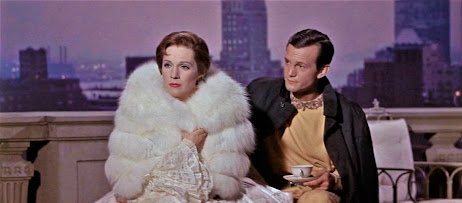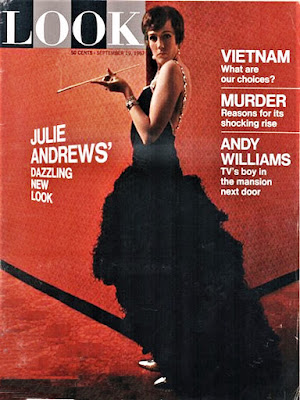Robert Wise: The Motion Pictures (Revised Edition) by J. R. Jordan - 2020
 |
The Pause That Refreshes.
Director Robert Wise hoists a Coca-Cola on the set of West Side Story with the film's star Natalie Wood. Wise co-directed West Side Story with choreographer Jerome Robbins, their twin 1963 Oscar win for Best Director was the first time the directing award had ever been shared. (Photo not featured in book.) |
By rights, the director of the movie that
single-handedly saved 20th Century Fox from bankruptcy should be as well-known as John Ford or Howard Hawks. And if that same fellow received
his first of seven career Academy Award nominations (four wins) for editing one of the most highly-acclaimed
motion pictures in American cinema, you'd think he'd be at least as talked and written about as William Wyler or George Cukor. Now, what if this guy was also responsible for two of the most iconic movie musicals of all time...films that made a fortune for the studios, garnered Best Picture Oscar wins for both, and influenced the way movie musicals were made for years after...surely this director must be as famous as Orson Welles or Alfred Hitchcock. Right?
Answer: Well, not so much.
 |
The Sound of Music
Even die-hard devotees of the film have a hard time remembering who directed it. |
Of course, the person I’m referring to is the late director-producer
Robert Wise (1914 – 2005). It was Wise’s adaptation of the Broadway musical The
Sound of Music (1965) that rescued 20th Century Fox from the
threat of Cleopatra (1963)-induced bankruptcy. It was Wise who, at the
ripe old age of 26, edited the Orson Welles masterpiece Citizen Kane (1941) and received his first Oscar nomination. (Wise was also the person controversially tasked with whittling/butchering Welles' The Magnificent Ambersons (1942) down to 88 minutes from its original 148-minute running time.) And in 1962 and 1966, it
was Robert Wise who each year took home Oscars for Best Picture and Best Director in recognition for his work on West Side Story and The Sound of
Music respectively.
 |
West Side Story
According to the Jerome Robbins biography Somewhere, Robert Wise was "quite reluctant" when asked to co-direct with the Tony Award-winning choreographer/director of the original 1957 Broadway production. An agreement was struck granting Robbins control of the musical sequences, Wise the book scenes. Even with this, the producers fired Robbins some 45 days into the film's 7-month shooting schedule, citing his over-meticulousness as the cause for the film being severely and expensively behind schedule. |
Having directed some 40 motion pictures throughout his six-decade career—several now regarded as contemporary classics—Wise is hardly an unknown in film circles. Similarly, given the many
positions of honor he held in his lifetime (president of both the Academy of
Motion Picture Arts & Sciences and The Director’s Guild) and the number of industry
trophies bestowed upon him (the aforementioned four Academy Awards, The Irving
G Thalberg Memorial Award, The Director’s Guild D.W. Griffith Award, and The AFI
Life Achievement Award), Wise isn’t even a filmmaker about whom it can be
said had a career that went unrewarded.
 |
Two for the Seesaw
Wise uses space to dramatize the isolation of characters played by Shirley MacLaine & Robert Mitchum |
The boon and bane of Robert Wise’s career has always been his
versatility and disinterest in imposing a defining “A film by Robert Wise” signature
on his movie.
“Some of the more esoteric critics claim there is no
Robert Wise style or stamp. My answer to that is that I’ve tried to approach each
genre in a cinematic style that I think is right for that genre.” -
Robert Wise The Los Angeles
Times 1998
The range of genres Wise worked in is staggering. Film-Noir:
Born to Kill (1947) / Western: Blood on the Moon (1948) / Sports:
The Set-up (1949) / Comedy: Something
for the Birds (1952) / War: Destination Gobi (1953) / Bio: I Want
to Live (1958) / Crime: Odds Against Tomorrow (1959) / Romance: Two
for the Seesaw (1962) / Adventure: The Sand Pebbles (1966) / Musical:
- Star! (1968) / Horror: The Haunting (1963) / and Sci-Fi: Star
Trek: The Motion Picture (1979).
 |
The Hindenburg
Suspicious-looking onlooker Roy Thinnes skulks behind Colonel George C. Scott and Countess Anne Bancroft, whose opium addiction has her airborne long before the dirigible ever leaves the ground. |
And while Robert Wise may not have been the most hands-on director, his films led many a performer to Oscar wins and nominations (Steve McQueen received his only Oscar nomination for The
Sand Pebbles).
—From the book Robert Wise: The Motion Pictures by
J.R. Jordan—
René Auberjonois on working with Wise on The Hindenburg
(1975): “But I have very little recollection of Robert directing me as an
actor. And that is unique, really. I didn’t have much of an actor-director
relationship with him.”
Janette Scott on working with Wise on Helen of Troy
(1956): “From our perspective, he didn’t really direct. He would place us
and say things like, ‘Let's try it.’
 |
The Day the Earth Stood Still
Michael Rennie (left) no doubt feeling ill. |
Historically speaking, if Wise suffers from anything, it's from a lack of legacy. He's a director with
no visibility (there aren't any Alfred Hitchcock-like walk-ons in a Robert Wise movie); no public persona (he didn't make the talk-show circuit like Otto Preminger); no mystique (there are no juicy anecdotes detailing displays artistic temperament); and impossible to "type" (versatility resists branding). When film enthusiasts and scholars talk about the directors of the studio
system era, the name Robert Wise is conspicuous in its absence. Underrated and
overlooked in comparison to his peers, Robert Wise is the Jan Brady of film
directors. The Rodney Dangerfield of Cinema.
 |
Photo: Los Angeles Times Robert Wise's reputation as a director worthy of scholarly evaluation took a serious blow in 1968 when influential film critic and Auteur Theory advocate Andrew Sarris summarily dismissed the versatile director as a "technician without a strong personality," and claims that Wise's stylistic signature was "indistinct to the point of invisibility." |
Hoping to rectify this is the book— Robert Wise: The
Motion Pictures by J.R. Jordan, originally published in 2017 and now available
in a revised and updated edition. Robert Wise: The Motion Pictures is a well-researched, sizable volume
(506 pages) that takes a comprehensive, chronological look at the full body of
Robert Wise's career output as a director. All 40 of Wise’s feature films are highlighted,
including his last, a TV-movie filmed when the director was 85-years-old.
The book is divided into five sections, each representing a significant period in Wise’s career (section titles are the author’s, the descriptors my
own):
RKO Pictures – B-movies under the tutelage of horror master Val
Lewton.
The Fifties – His most prolific period.
Primetime – The ‘60s, his most successful decade.
The Science and Surrealism of the Seventies – Big budgets &
modest returns.
Twilight – His brief return to filmmaking following a
10-year absence.
 |
The Haunting
My favorite Robert Wise film is also one of the most effective haunted house films I've ever seen |
An entire chapter is devoted to each of Wise’s films. The chapters
comprise a thematic quote; plot description; details about the making of the movie;
trivia and behind-the-scenes-info; pertinent screen dialogue; and in some
instances, interviews with actors and other individuals involved in the production. More than 20 interviews were conducted for the book, among those contributing their
thoughts on working with Wise are Marsha Mason (Audrey Rose), George Chakiris
(West Side Story), Lindsay Wagner (Two People), René Auberjonois
(The Hindenburg), Earl Holliman (Destination Gobi), Billy Gray (The
Day the Earth Stood Still), and Janette Scott (Helen of Troy). For me, these interviews are an entertaining and informative highlight.
Featuring an index, bibliography, and where necessary, citation
footnotes, it’s a book that can be read cover to cover (as I did) or used for reference.
 |
Star!
When it came to Wise's return to the musical genre, three failed to be the charm. The expensive, tuneful, and colorful musical biography of Gertrude Lawrence was as big a flop as The Sound of Music was a hit.
|
Because so many of Robert Wise’s movies are so well-known
and popular, yet Wise remains a director about whom little has been written, it’s
natural to approach this sizable volume with a great deal of expectation. (In
my case, over-expectation. I’m a big fan of Robert Wise, but the last book I
read about him was back in 2007…Richard C. Keenan’s The Films of Robert Wise.) So, at this
point, I need to emphasize that one's enjoyment of Robert Wise: The Motion
Pictures will be significantly enhanced by understanding clearly what the
book is and what it isn’t.
 |
Odds Against Tomorrow
Produced by Harry Belafonte and credited as the first film-noir to star a Black actor
|
Robert Wise: The Motion Pictures
is not an academic work of film scholarship and doesn’t present itself as such. More
an appreciation and career tribute to Wise, Jordan approaches his subject with
a film-buff’s enthusiasm and a well-informed informality. Biographical
information about Wise, personal or professional, is minimal, the emphasis being
on letting the films speak for themselves, letting actors and industry
professionals share their thoughts on working with Wise, and highlighting each
film’s production and content. As per the latter, perhaps an overabundance of
riches. Unaccountably detailed plot descriptions dominate the book, it not
being unusual for 5 pages of a 9-page chapter to be devoted to the recounting
of a film’s storyline alone.
 |
Audrey Rose
Marsha Mason and John Beck wonder if the reincarnated can reverse charges
|
For me, Robert Wise: The Motion Pictures succeeds as
an introduction and primer for those unfamiliar with the director, and as a solid
reference book supplement to the already existing books about Robert Wise (I’m
only aware of their being 5 total). I would think this book would prove very useful in this age of streaming sites and online movie accessibility, its chapter-by-chapter highlighting of each film serving as a guide for the unfamiliar, a recap to the initiated.
Should there be a 2nd revised edition of Robert Wise: The Motion Pictures, I hope the opportunity presents itself for a strong editor to tighten up the prose a bit. There's so much worthwhile in Jordan's book, yet I suspect its form as is might keep well-read cinema enthusiasts away. It's great to have a book dedicated to the entire body of Robert Wise's directing career, even better to encounter such a sincere tribute to a man who, by all accounts, was an unusually kind, principled, and self-effacing director whose movies continue to touch many lives.
 |
The Andromeda Strain
You know it's science fiction when Paula Kelly and James Olson battle an uncontrolled
outbreak of a deadly virus and there's no one around bitching about having to wear a mask.
|
Indeed, the
major through-line of each and every interview conducted in the book can be
found in this quote by a pre-The Bionic Woman Lindsay Wagner, whom Wise directed
in her first film Two People (1973):
“Robert (Wise) to this day remains one of the nicest, most
gracious film directors I’ve ever encountered. Consequently, my indoctrination
to the business was that power, success, and kindness can all coexist. Because
to me, those are the characteristics that defined Robert Wise.”
The author provided a review copy of the book.
All screencaps are from Robert Wise movies in my personal DVD collection.
 |
Simone Simon and Ann Carter in The Curse of the Cat People (1944)
Taking over the reins from original director Gunther von Fritsch, this RKO film
produced by Val Lewton marks Robert Wise's debut as a film director. |
Copyright © Ken Anderson 2009 - 2021

































